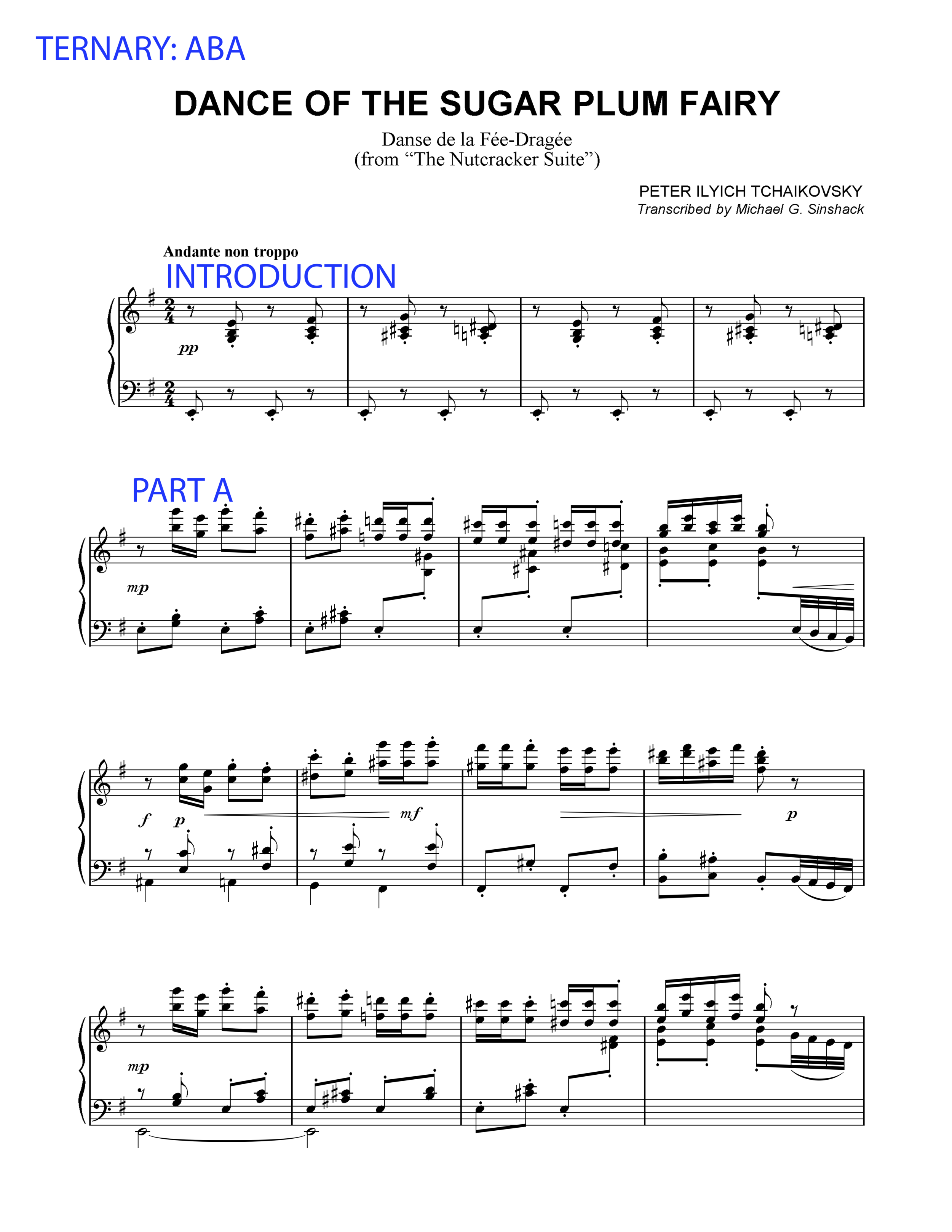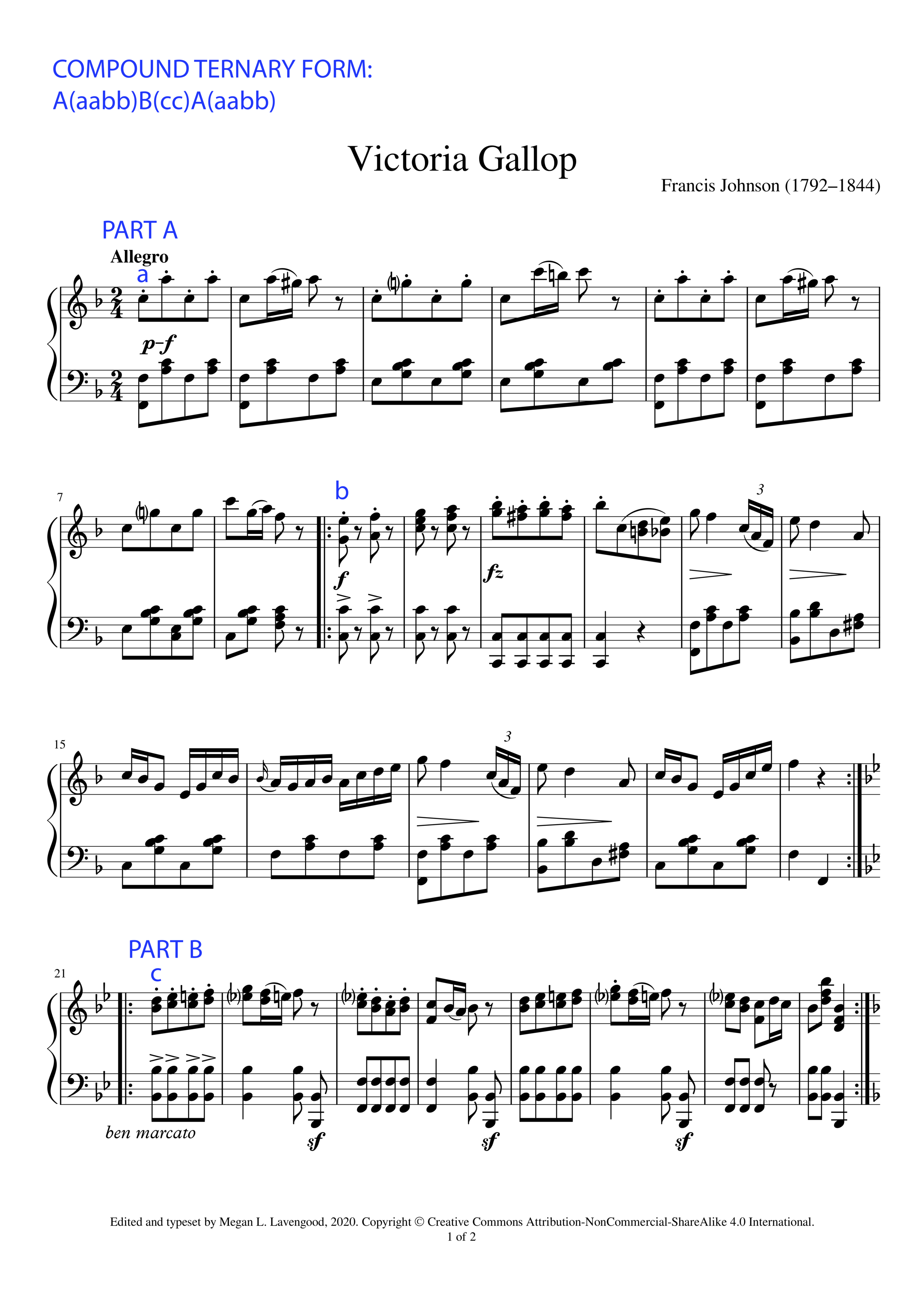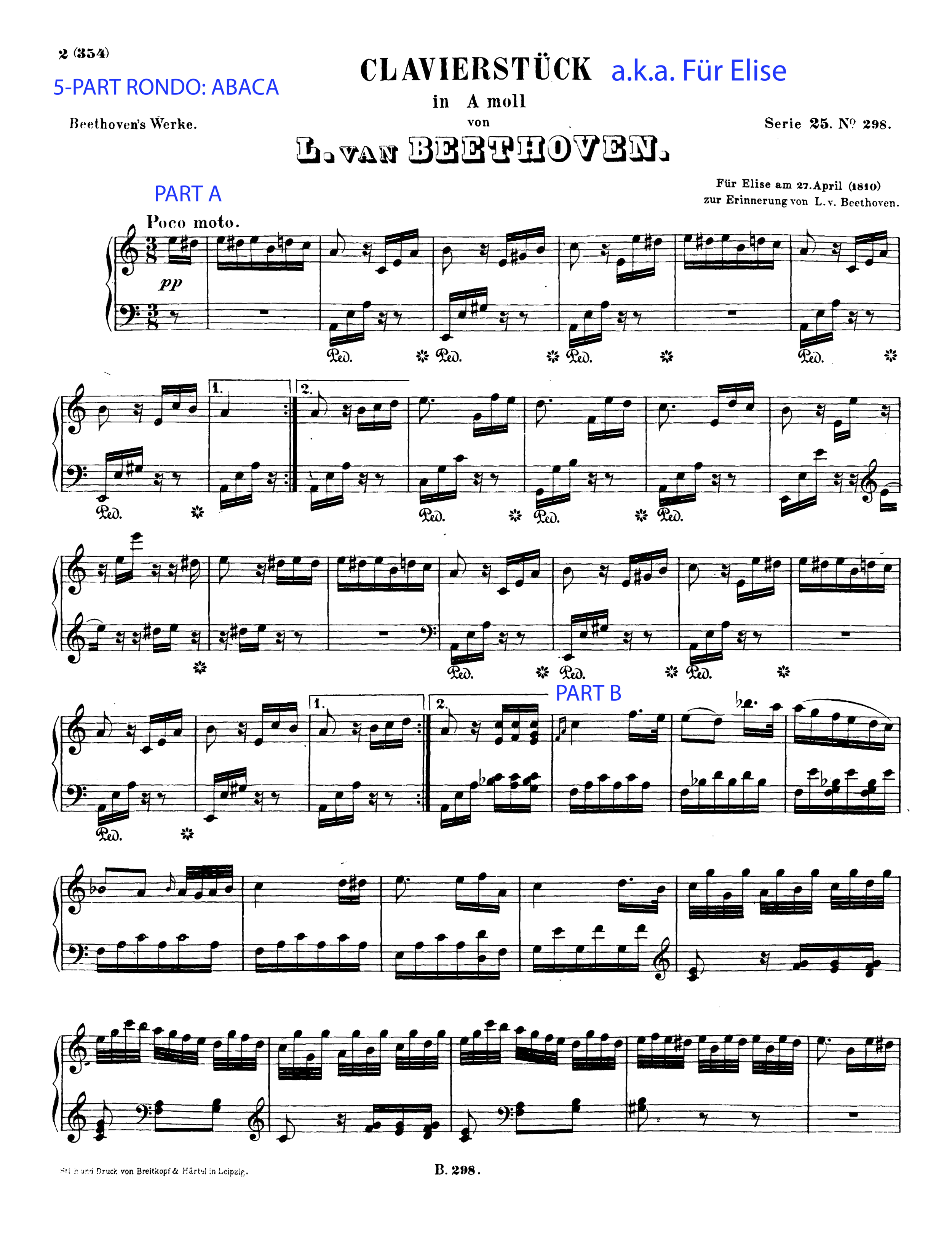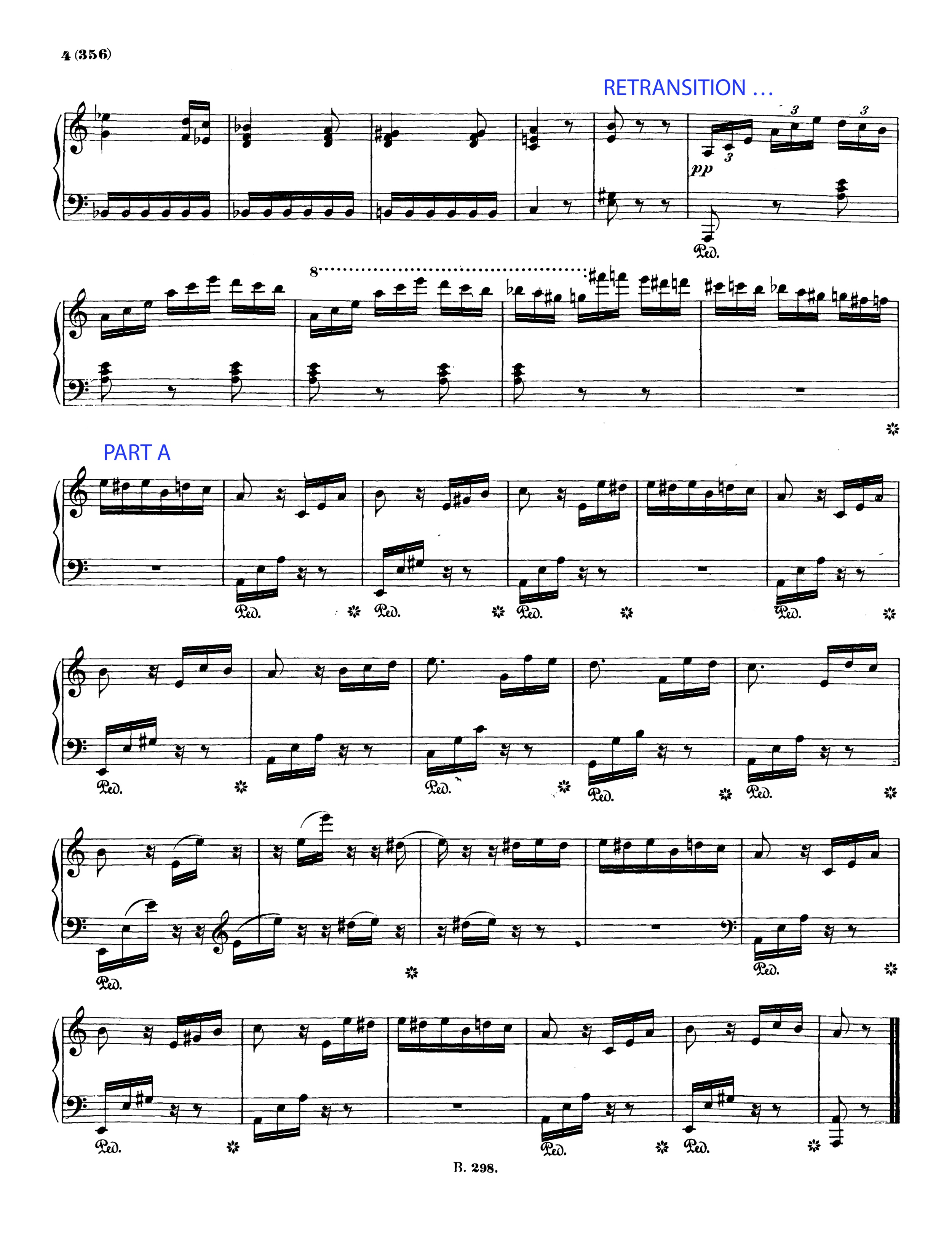TERNARY & RONDO FORMS
This page is a supplement to The Complete Musician: Chapter 25 - Ternary Form and Chapter 26 - Rondo Form
Unlike the binary and theme and variation forms we have previously studied, ternary and rondo forms are more varied and fragmented in their presentation of materials. In addition to larger, multi-movement forms such as symphonies, suites, concerti, and song cycles, ternary and rondo forms are considered COMPOSITE because of the sectionalization of their segments.
TERNARY FORM
The TERNARY FORM is a three-part piece of continuous music in an ABA (or ABA’) structure where the outer two sections are identical or practically identical and the interior section is fundamentally different. Ternary form is not to be confused with rounded binary as the A and B are more interrelated than in ternary.
Sometime the sections are related by key or transitional material that helps the musical elements move between sections. The transitional material that leads away from the piece’s primary tonic key is called a TRANSITION, which is shocking, frankly. The transition material that returns the piece to its primary tonic key is called a RETRANSITION which is not a real word, so that is more on brand for music theory.
There are three typical types of ternary designations based on the tonality of the three sections:
SECTIONAL TERNARY: Most often, the first A section moves away from its own tonic as a way to lead into the B section. The B section then finishes in its own tonic before moving to the final A. Spatially, it could be looked at as AB | A. On occasion, sectional ternary pieces might have a more resolute first A with the continuous movement between B and the second A like this: A | BA.
FULL SECTIONAL TERNARY: Each of the three sections (A, B, and A’s reprise) finish on the tonic chord of the key it started in. A | B | A
CONTINUOUS TERNARY: Each of the three sections finish on a different chord than its key center’s tonic. ABA
It is very difficult to tell the difference between continuous ternary and sectional ternary with transitions. For the most part, continuous ternary will feel more complete while sectional ternary with transitions will have partial phrases featuring modulating elements.
A great many ternary pieces are disguised with the use of DA CAPO AL FINE (D.C.), a publishing tactic meant to save ink in which the musician performs an A and B section and then is instructed to return to the beginning (da capo = to the head … like “decapitate”) to repeat the A section again before a Fine (end) marking.
Minuet Dance Notation
The da capo figure is also used prevalently in the DA CAPO ARIA form popular in the Baroque era in which a singer performs two contrasting sections (A and B), then returns to the top, performing a highly ornamented version of the A section to show off their skill and technique.
The popularity of the vocal da capo aria eventually waned in the 19th century and was replaced with the character piece as the most popular ternary form while a surge of instrumental music tipped the scale. A CHARACTER PIECE is a short, single-movement work most often for solo piano (but sometimes for a featured instrument with piano accompaniment) in ternary form portraying a character, mood, or short scene.
On occasion, the ternary form may be broken down into smaller forms. For instance, the A, B, and final A might actually contain within them entire binary forms. Because these ternary forms are made up of smaller forms, they would be considered COMPOUND TERNARY FORM. To analyze this, the smaller forms within would be labeled with lowercase letters (a, b, etc.) and the larger form would be labeled with uppercase letters (A, B, etc.).
One such compound ternary form is the MINUET-TRIO, a work popularized in the Classical era as a stand-alone movement of a symphony, suite, sonata, serenade, or divertimento. Both the minuet and trio are in a dance-tempo simple triple meter (3/4 time) and both are presented in binary form with directions indicating to repeat the minuet upon completing the trio, making the work a full sectional compound ternary form.
Most large-scale instrumental forms in Western Classical music can be traced back to specific dance sequences from the Renaissance and Baroque Eras where it was common for European gentry to learn complex sequences of dance moves (such as the 1750 “Spanish” Minuet pictured here) in order to gain social status at social events at court.
SOME TUNES IN TERNARY FORM …
DANCE OF THE SUGARPLUM FAIRIES - PYOTR ILYICH TCHAIKOVSKY
Introduction (0:00)
A (0:09) - 16 bars (abac)
B (0:42) - 8 bars (dd)
Retransition (1:06) - 4 bars leading back to A
A (1:14) - 16 bars (abac)
Coda - (not in the transcription below)
VICTORIA GALLOP - FRANCIS JOHNSON
A (0:06) - 4 8-bar phrases (aabb)
B (0:54) - 2 8-bar phrases (cc)
A (1:14) - 4 8-bar phrases (aabb)
Francis Johnson and his bonkers French horn.
FRANCIS JOHNSON (1792 - 1844) was a free Black man born in Philadelphia and is considered to be the first African American composer of Western Classical Music as well as the first conductor of an American music ensemble that toured outside the United States.
RONDO FORM
The rondo form is an extension of the ternary form in that it keeps a similar pattern but does not stop at just three sections. A RONDO/RONDEAU FORM generally consists of some symmetrical pattern of a first theme, presentation of new theme, and return to the first theme before continuing on to another theme. An infinite pattern of rondo form could look like ABACADAEAFAGAHA … etc. However, most are in five (ABACA) or seven (ABACABA) parts. Notice in the seven-part rondo that the fourth opportunity to present a new theme (where D would go) is replaced with the B theme again, making the seven-part a truly symmetrical form.
All A sections are referred to as REFRAINS because they are repeated back to (this is similar to the “chorus” in a song in that they are almost always identical restatements).
All non-A sections (B, C, D, etc.) are referred to as EPISODES because the material occurs once or, rarely, twice.
Rondos are generally larger COMPOUND forms (like ternary above), comprised of smaller forms like binary phrases strung together in the rondo layout. As with ternary, the larger rondo form is analyzed with uppercase letters and the smaller inner forms are analyzed with lowercase letters.
Rondos can be found as part of the French Baroque Dance Suite (a rondeau being a specific dance style in the Renaissance era) and they made their way into the dance suite as the original RONDEAU: a French song with a refrain sung by a group and original episodes sung by soloists. In later eras, the form was often used as the final movement of a multi-movement large-scale work such as a symphony or sonata.
Rondos can also feature connective material such as TRANSITIONS and RETRANSITIONS just like ternary form and, additionally, codas. A CODA is an optional ending in music that consists of new material stitched to the end of the final formulaic phrase. In rondos, a coda might be found as an extra section of musical material beyond the final A refrain and can be as short as a single phrase.
SOME TUNES IN RONDO FORM …
Für Elise - Ludwig Van Beethoven
A (0:03) - rounded binary
B (0:55) - 2 8-bar phrases
A (1:26) - rounded binary
C (2:06) - 2 8-bar phrases with a retransition to A
A’ (2:48) - ternary (aba) this time
I’ll Be Watching You - Sting and the Police
Introduction (0:00)
A (0:16) - two 8-bar phrases (E Minor)
B (0:50) - one 8-bar phrase (G Major)
A (1:05) - one 8-bar phrase (E Minor)
C (1:23) - two 8-bar phrases (Eb Major)
A (1:46) - instrumental (E Minor)
B (2:15) - one 8-bar phrase (G Major)
A’ (2:30) - two 8-bar phrases (modified/E Minor)
Coda (3:02) - fade out (E Minor)










